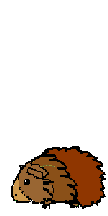The Guinea Pig Arcade &
Crazy Cavy Fun House
home of the one and only
🐹 🦖🐹
Guineazilla!

When this guy "WHEEKS" you had better listen!
Are you worried about your guinea pig gaining too much weight? Have you been shocked at the size of the cuy pigs from South America? Well, have we got a guinea pig ancestor for you!
Josephoartigasia monesi, which is closely related to modern guinea pigs, is thought to have weighed a metric tonne.
Scientists used computer simulation methods to estimate how powerful a bite it had, and came up with a force of around 1,400 Newtons – about the same as that of a tiger’s clamping jaws.
Their incisors would have been able to withstand almost three times that amount of force though, according to the research.


The fossil remains of a giant rodent that weighed an estimated 1,500 pounds (700 kilograms) is helping scientists form a clearer image of what northern South America was like some eight million years ago.
Heralded as the world's largest rodent,Phoberomys pattersoni looked more like a giant guinea pig (Cavia porcellus) than an oversized house rat (Rattus rattus) and it apparently flourished on a diet of vegetation.
"Phoberomys was most likely a herbivore, and I seriously doubt it was a pest," said Marcelo Sánchez-Villagra, a paleontologist at the University of Tübingen in Germany. "When thinking of Phoberomys, think guinea pig, not rat."
Orangel Aguilera, a zoologist with the Universidad Francisco de Miranda in Venezuela, together with a colleague, discovered the Phoberomys fossils in 1999 in the Urumaco Formation, a desert region near the northwest coast of Venezuela.
Sánchez-Villagra and Ines Horovitz, a professor of organismic biology, ecology, and evolution at the University of California, Los Angeles, together with Aguilera, performed detailed studies of the fossils beginning in 2002. The team's report was published in the September 19 issue of the journal Science.
"It's really an exciting find," said Louise Emmons, a field biologist who specializes in neotropical mammals at the Smithsonian Institution in Washington, D.C.
National Geographic News, John Roach,September 22, 2003
